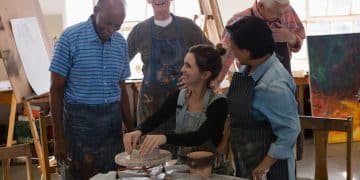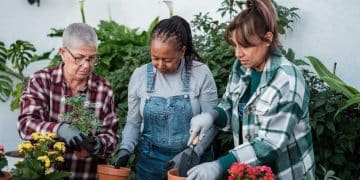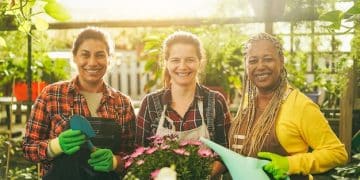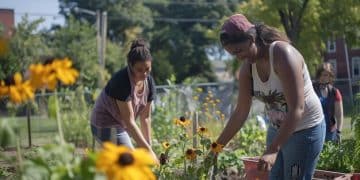Community Action Project Sustainability: Building a Long-Term Funding Model That Lasts Beyond 2025
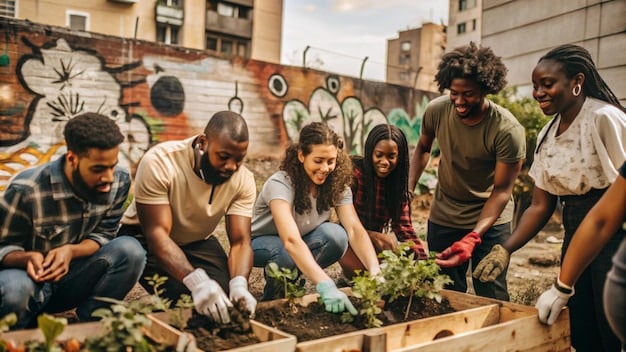
Community Action Project Sustainability: Building a Long-Term Funding Model That Lasts Beyond 2025 requires diversifying funding streams, engaging the community, and implementing robust evaluation processes to ensure long-term impact and resilience.
Community action projects are vital for addressing local needs and fostering positive change. However, securing long-term funding can be a significant challenge, threatening their sustainability and impact. The key lies in Community Action Project Sustainability: Building a Long-Term Funding Model That Lasts Beyond 2025.
How can we ensure these projects thrive beyond short-term grants and fluctuating economic conditions? This article explores strategies for developing a sustainable funding model that empowers community initiatives to continue their essential work for years to come.
Understanding the Importance of Sustainable Funding
Securing funding is a constant concern for many community action projects. Without a reliable funding model, these important initiatives risk losing their ability to serve the community effectively. Understanding the nuances of Community Action Project Sustainability: Building a Long-Term Funding Model That Lasts Beyond 2025 is the first step of ensuring project continuity.
Why Short-Term Funding Isn’t Enough
Short-term grants, while helpful, often create instability. Community projects require a long-term vision and a solid financial foundation to achieve lasting results. Relying solely on year-to-year funding leaves projects in a precarious position, unable to plan for the future or expand their impact.
The Benefits of Long-Term Sustainability
A sustainable funding model that focuses on Community Action Project Sustainability: Building a Long-Term Funding Model That Lasts Beyond 2025 provides numerous benefits. It enables projects to:
- Plan strategically for future programs and initiatives
- Attract and retain qualified staff
- Build strong relationships with community partners
- Demonstrate a consistent commitment to addressing local needs

Ultimately, establishing a sustainable funding model ensures that community action projects can continue to make a positive difference in people’s lives for many years to come. By prioritizing sustainable funding, these invaluable initiatives can focus on achieving their missions without the constant worry of financial uncertainty.
Diversifying Funding Streams for Resilience
Relying on a single source of funding makes community projects vulnerable to economic downturns and shifting priorities. Diversifying funding streams is a crucial step towards achieving both resilience and Community Action Project Sustainability: Building a Long-Term Funding Model That Lasts Beyond 2025.
Exploring Different Funding Options
There are various funding options available to community projects, including:
- Individual Donations: Engaging community members to contribute financially through online platforms, fundraising events, and recurring donation programs.
- Corporate Sponsorships: Partnering with local businesses to secure sponsorships for specific programs or events, providing mutual benefits and visibility.
- Government Grants: Pursuing grants from federal, state, and local government agencies that support community development and social services.
- Earned Income Strategies: Developing revenue-generating activities, such as selling goods or services, offering workshops or training programs, or renting out facilities.
Building a Balanced Portfolio
Creating a balanced funding portfolio involves combining multiple funding streams to create a reliable and adaptable financial base that supports Community Action Project Sustainability: Building a Long-Term Funding Model That Lasts Beyond 2025. This approach minimizes risk and maximizes opportunities for growth and innovation.
By carefully selecting and blending different funding options, community projects can build a resilient financial foundation that ensures long-term stability and program effectiveness. Diversification is the key to navigating economic uncertainties and sustaining positive community impact.
Engaging the Community in Fundraising Efforts
Community engagement not only enhances project impact but also strengthens fundraising efforts. People are more likely to support initiatives that they feel connected to and invested in. Emphasizing Community Action Project Sustainability: Building a Long-Term Funding Model That Lasts Beyond 2025 can also significantly boost fundraising success.
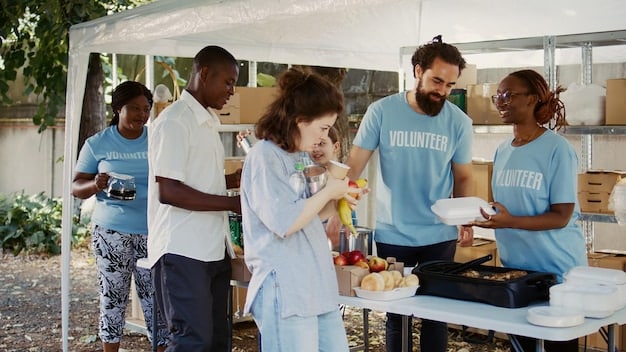
Building Relationships with Stakeholders
Cultivating strong relationships with community members, local businesses, and other stakeholders is essential. This involves actively seeking their input, involving them in decision-making processes, and recognizing their contributions.
Effective Community Engagement Strategies
Consider these strategies to boost local involvement and promote Community Action Project Sustainability: Building a Long-Term Funding Model That Lasts Beyond 2025:
- Organize community events: Host workshops, festivals, and gatherings to raise awareness and build a sense of community ownership.
- Utilize social media: Share project updates, success stories, and volunteer opportunities through engaging social media campaigns.
- Create a volunteer program: Offer meaningful volunteer roles that empower community members to contribute their time and skills.
By prioritizing community engagement, community projects can cultivate a strong base of support, deepen their impact, and enhance their long-term sustainability.
Implementing Earned Income Strategies
Earned income strategies offer a powerful pathway to financial sustainability for community action projects. Creating revenue streams that align with the project’s mission reduces reliance on external funding and ensures Community Action Project Sustainability: Building a Long-Term Funding Model That Lasts Beyond 2025.
Identifying Opportunities for Revenue Generation
Explore opportunities that align with your mission and resources. These could include:
- Selling goods or services: Offer products or services that meet a community need and generate revenue.
- Providing training or workshops: Share your expertise through workshops, training programs, or consulting services.
- Renting out facilities: If you have underutilized space, consider renting it out for events or meetings.
Case Studies of Successful Earned Income Models
Example 1: A Community Garden
This garden could sell produce at a local farmers market, host gardening workshops, or offer subscriptions for weekly vegetable deliveries. This promotes Community Action Project Sustainability: Building a Long-Term Funding Model That Lasts Beyond 2025 with agricultural practices.
Example 2: A Youth Center
This center could offer after-school tutoring, summer camps, or facility rentals for community events. A successful youth center directly contributes to Community Action Project Sustainability: Building a Long-Term Funding Model That Lasts Beyond 2025 by empowering future generations.
Example 3: A Community Arts Program
This program could sell artwork, offer art classes, or host exhibitions that generate revenue. This not only brings funding in, but helps sustain local art in accordance with Community Action Project Sustainability: Building a Long-Term Funding Model That Lasts Beyond 2025.
By embracing earned income strategies, community projects can enhance their financial stability, diversify their funding sources, and strengthen their long-term impact.
Building Strategic Partnerships for Greater Impact
Strategic partnerships can significantly expand the reach and resources of community action projects. Collaborations with other organizations, businesses, and government agencies offer invaluable opportunities to leverage expertise, share costs, and promote Community Action Project Sustainability: Building a Long-Term Funding Model That Lasts Beyond 2025.
Identifying Potential Partners
When searching for partners, consider organizations that share your mission, target the same population, or offer complementary services. Look beyond your immediate network and research potential collaborations in your community and beyond.
Creating Mutually Beneficial Relationships
The most successful partnerships are built on mutual benefit and shared goals. Clearly define the roles, responsibilities, and expectations of each partner from the outset. Establish a formal agreement that outlines the terms of the collaboration and provides a framework for accountability. Prioritizing Community Action Project Sustainability: Building a Long-Term Funding Model That Lasts Beyond 2025 will help maintain strong partnerships.
Leveraging Resources and Expertise
Strategic partnerships can provide access to new resources, expertise, and networks. Partners may offer funding, in-kind donations, technical assistance, or volunteer support. By leveraging these resources, community projects can expand their capacity, enhance their effectiveness, and achieve greater impact.
Strategic partnerships are essential for creating a strong, interconnected network of support that enables community projects to thrive. By collaborating with other organizations, projects can maximize their impact and ensure long-term sustainability focused on Building a Long-Term Funding Model That Lasts Beyond 2025.
Measuring and Communicating Impact Effectively
Demonstrating the impact of community action projects is critical for attracting funding and building support. Investing in robust evaluation processes allows you to measure your progress, identify areas for improvement, and effectively communicate your achievements. Highlighting successes is key to Community Action Project Sustainability: Building a Long-Term Funding Model That Lasts Beyond 2025.
Developing Key Performance Indicators (KPIs)
KPIs should be specific, measurable, achievable, relevant, and time-bound (SMART). They should reflect your project’s goals and objectives and provide clear indicators of progress. Consider these examples:
- Number of people served
- Percentage of participants who achieve desired outcomes
- Community satisfaction rates
Collecting and Analyzing Data
Collecting high-quality data is essential for accurate evaluation. Implement data collection methods such as surveys, interviews, focus groups, and program records. Analyze the data to identify trends, patterns, and areas for improvement. All of this contributes to Community Action Project Sustainability: Building a Long-Term Funding Model That Lasts Beyond 2025.
Communicating Results to Stakeholders
Share your evaluation results with community members, funders, partners, and other stakeholders. Use a variety of communication channels, such as reports, presentations, websites, and social media. Highlight your project’s successes and demonstrate the value of your work. Transparency and good publicity will help sustain Community Action Project Sustainability: Building a Long-Term Funding Model That Lasts Beyond 2025.
| Key Point | Brief Description |
|---|---|
| 💡 Diversify Funding | Mix donations, sponsorships, grants, and earned income for resilience. |
| 🤝 Engage Community | Involve locals in events and volunteering to boost support. |
| 📈 Measure Impact | Track KPIs and communicate achievements to attract funding. |
| 🤝 Strategic partnerships | Collaborate to expand your reach and resources. |
Frequently Asked Questions
Diversifying funding streams, engaging the community, and implementing robust evaluation processes are essential for ensuring long-term sustainability and financial stability.
Earned income reduces reliance on external funding and provides a sustainable revenue stream, allowing projects to maintain their programs and operations.
Engaged community members provide volunteer support, donate funds, and advocate for projects, strengthening their financial base and overall sustainability for Building a Long-Term Funding Model.
Partnerships can provide access to new resources, expertise, and networks, allowing projects to expand their reach, enhance their effectiveness, and maximize their impact.
Demonstrating impact attracts funding and support from stakeholders, helping projects to secure resources and sustain their operations for the long term, contributing to sustainability.
Conclusion
Achieving Community Action Project Sustainability: Building a Long-Term Funding Model That Lasts Beyond 2025 requires a multifaceted approach that combines diversified funding, active community engagement, strategic partnerships, and effective communication. By implementing these strategies, community projects can build resilient financial foundations that empower them to continue serving their communities for years to come.
Ultimately, sustainable funding is not just about money; it’s about creating a thriving ecosystem of support that strengthens community bonds and fosters positive change. By prioritizing sustainability, community projects can ensure their long-term impact and make a lasting difference in people’s lives.
